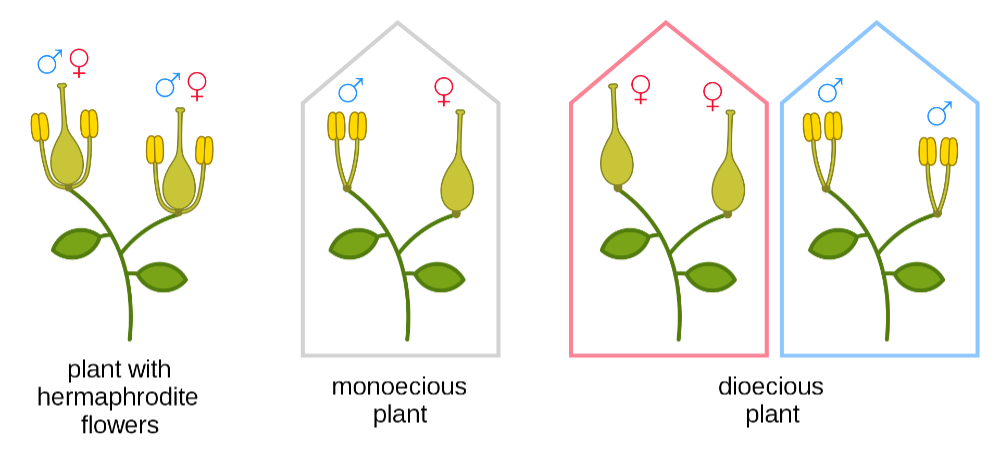 The Jujube Info and Care Reference Manual
The Jujube Info and Care Reference Manual- Plant Morphology (Phytomorphology)
- Flowers
- Classification of the Jujube Flower
Classification of the Jujube Flower
The Spermatophytes
The spermatophytes are the seed-producing plants, of which there are two groups: the Gymnospermae which produce cones and exposed seeds, and the Angiospermae which produce flowers and seed enclosed by fruits.
Gymnospermae
Gymnospermae, also called gymnosperms, are the oldest of the two groups, and date from about 319 million years ago in the late Carboniferous period.
‘Gymnosperm’ is from the Ancient Greek γυμνός, gymnós, ‘naked’, and σπέρμα, seed: ‘naked seed [seed not enclosed (by a fruit)]’.
Gymnosperms produce cones, and include conifers, cycads, gnetophytes, and the sole surviving ‘living fossil’ of its group, Ginkgo biloba (the maidenhair tree).
Angiospermae
Angiospermae, also called angiosperms, are the flowering plants, and the earliest known fossil (of pollen) dates to around 134 million years ago in the Cretaceous period. The earliest known plant fossil dates from 125 million years ago, also in the Cretaceous.
Angiosperm’ is from the Ancient Greek ἀγγεῖον, angeîon, ‘vessel, jar, receptacle’, and σπέρμα, seed: ‘seed in a container (fruit)’.
Angiosperms produce flowers, and from those, fruit.
The jujube tree, Ziziphus jujuba Mill. is both a spermatophyte and an angiosperm.
Spermatophyte Reproduction
In Gymnospermae
Cones are the sex organs of gymnosperms. Male cones produce pollen (made of pollen grains which contain sperm), and their female counterparts produce ovules (which contain unfertilised egg cells). Cones are thus unisexual, either male or female.
In Angiospermae
Flowers are the sex organs of angiosperms. Like cones, flowers also produce pollen (also comprised of sperm-containing pollen grains) and ovules (also comprised of egg cells). But unlike cones, which are only ever male or female, flowers can be one of four basic types as shown in the illustration below:

Attribution: by Nefronus - Own work, CC BY-SA 4.0, https://commons.wikimedia.org/w/index.php?curid=80317707
Flowers
Dioecious Species
Dioecious species are those with distinct male-only and female-only plants. While about 65% of gymnosperms are dioecious, only about 6% of angiosperms are. Male-only angiosperms produce male-only flowers and female-only angiosperms produce female-only flowers. Dioecious angiosperms thus produce unisexual flowers.
[An example of a dioecious gymnosperm is the Maidenhair tree (Ginkgo biloba), and of a dioecious angiosperm, the weeping willow (Salix babylonica). The female tree of each cannot make fertile seed without a male counterpart close enough for its pollen to reach.]
Monoecious Species
Monoecious species are those with either distinct male and female sex organs on the same plant, or, specifically in the case of angiosperms, flowers on the same plant with both male and female parts.
Although about 65% of all gymnosperms are dioecious, almost all conifers (which are gymnosperms) are monoecious and produce both male cones and female cones on the same plant. But we shall leave gymnosperms here, and focus solely on angiosperms from hereon in.
As with dioecious angiosperms, the flowers on monoecious angiosperms which are either male or female are also unisexual flowers. The flowers on monoecious species which contain both male and female parts are called bisexual, hermaphroditic, or perfect flowers.
The jujube tree Ziziphus jujuba Mill. is a monoecious species, and its flower is a perfect flower.
Dichogamy
Some animals change sex during their life — the clownfish is just one of many examples — and this is called sequential hermaphroditism in animals.
A change from male to female is called protandry (or protoandry), and from female to male is protogyny.
Sequential hermaphroditism in plants is called dichogamy. The striped maple (Acer pensylvanicum) appears to change sex to female or female and male in response to damage or disease, and every species within the Arisaema plant genus changes its sex either from year to year or as it gets bigger over the years.
Sequential hermaphroditism, whereby the plants change sex, is actually very rare in botany. More common is the sequential hermaphroditism (dichogamy) of flowers. However, the term in this context doesn’t mean that the flowers literally change from male to female or vice versa, but that the male and female parts develop at different times.
Dichogamy exists in both monecious and dioecious angiosperms.
Dichogamous flowers can be either protandrous, where the male unisexual flowers, or male parts of bisexual flowers develop first, or protogynous, where the female unisexual flowers, or female parts of bisexual flowers develop first.
In the Jujube Flower
For now, please note that the jujube flower is protandrous. Its male parts develop ahead of the female parts. We shall explore the details of this, and its significance, in future chapters.
Summary
The jujube tree is a species known as Ziziphus jujuba Mill..
It is a spermatophyte, or a plant which produces seeds. More specifically it is an angiosperm, or a plant which produces seeds in fruit from fertilised flowers.
(This is distinct to the only other seed-producing group, the gymnosperms, which produce seeds in cones.)
Z. jujuba is also a monoecious species, producing flowers with both male and female organs on the same plant.
The jujube flower, with male and female organs in the one flower, is known as hermaphroditic, bisexual, or perfect.
The flower is also dichogamous, in that one organ matures ahead of the other.
The male organ of a jujube flower develops first, and this is known as protandry. (Protogyny is where the female organ develops first.)
About the Author
BSc(Hons), U.Syd. - double major in biochemistry and microbiology, with honours in microbiology
PhD, U.Syd - soil microbiology
Stumbled into IT and publishing of all things.
Discovered jujube trees and realised that perhaps I should have been an agronomist...
So I combined all the above passions and interests into this website and its blog and manuals, on which I write about botany, soil chemistry, soil microbiology and biochemistry - and yes, jujubes too!
Please help me buy a plant if you found this article interesting or useful!